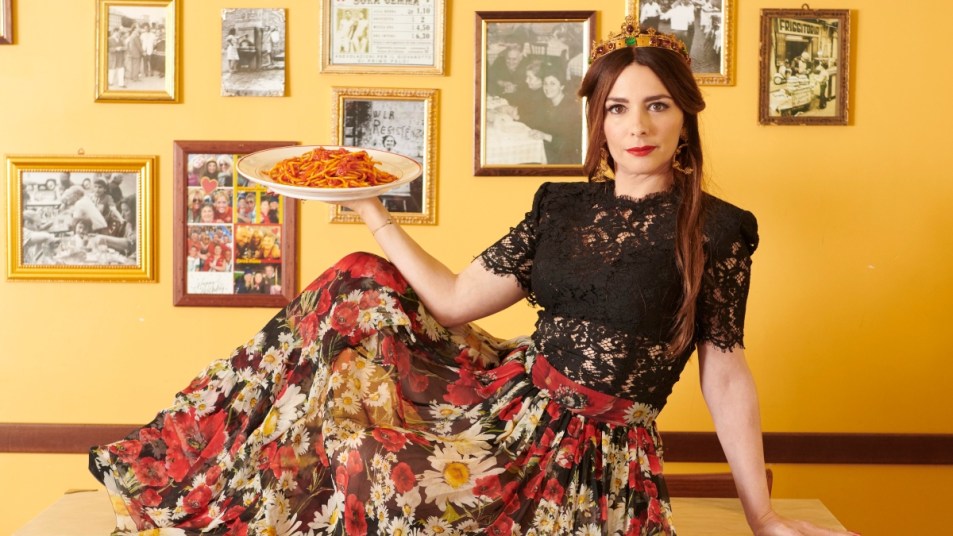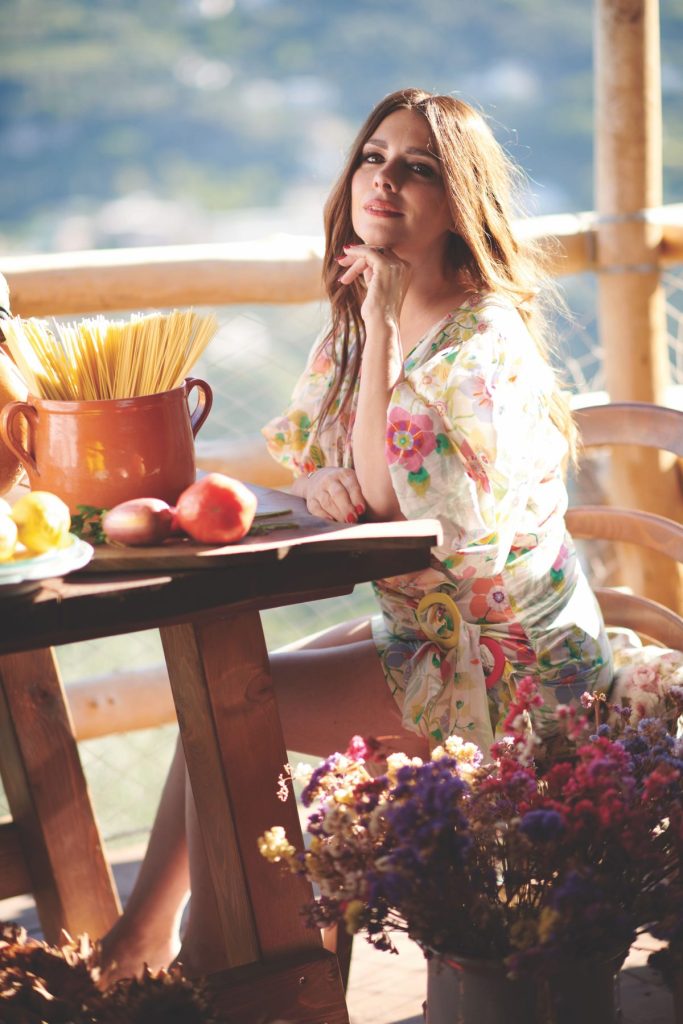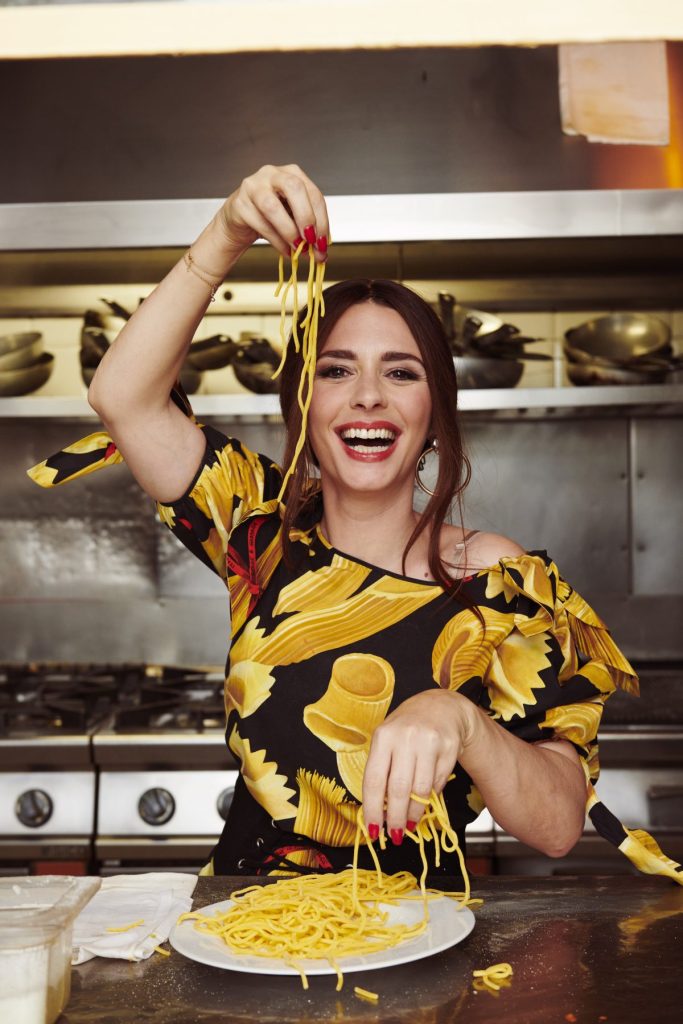The Pasta Queen Talks Food, Family, and What Makes a Dish “Just Gorgeous”
Buon appetito!

Pasta’s superpower is versatility. It can be luxurious and romantic, laden with rich sauces and fresh herbs; or it can be simple and satisfying, coming together quickly from just a few pantry staples. Nobody understands this better than Nadia Caterina Munno. Also known as ‘The Pasta Queen,’ her cooking credentials rest on her heritage: She comes from a long line of Italians who cultivate, cook, and love pasta. Her debut book, The Pasta Queen: A Just Gorgeous Cookbook, includes numerous pasta recipes and a multitude of pasta-making tips and tricks handed down through generations.
I spoke with Munno about what pasta means to her, the importance of family, and how to take basic ingredients from humble to regal.

You talk in your book about your history with pasta — even cultivating wheat with your grandparents in Italy as a child to make fresh pasta from scratch. What is it about pasta that has continued to excite you into adulthood?
NM: You know how much Italians are fond of pasta. I’ve done a lot of pasta research and history, of course, because there are five generations of pasta [making] in our family. But it’s really a staple; simple food that can be made for any diet. Anybody on any type of diet — whether they are vegan, vegetarian, or carnivore — can enjoy pasta… Now there’s even amazing gluten-free alternatives so that people who don’t eat grains can have pasta. I mean, to me, pasta is obviously close to my [heart]. I mean, I grew up swimming in wheat berries from when I was a toddler, and it’s a very big focus and focal point of Italian culture. The word “pasta” is seen in every country. Everybody knows pasta. It’s easy, it’s cost effective, and it makes people so happy because it’s delicious.
Most of our readers, myself included, are more familiar with dried, store-bought pasta than the fresh-made kind. What are your tips for turning a regular box of dried pasta into something amazing?
My family comes from dried pasta. So often, people think that Italians make fresh pasta daily. But as a culture, we mostly buy dried pasta that you get in a box, because it’s easy to store and it’s an easy way to have food available in the pantry without it spoiling. So for me, most of the pasta dishes in my book are done with boxed, dried pasta. Of course, when I choose pasta that is boxed, I choose a specific pasta that has been slow-dried and made with bronze dies, and that follows the old, traditional methods of wind and sun to make it, which is very commonly available these days in the US. You can find slow-dried, bronze-extruded pasta from boxes in grocery stores, speciality stores, online, everywhere. I would say 90 percent of the recipes that you see in my book have been done with boxed pasta. Sometimes I prefer it over fresh pasta because the wheat is harder. The heavy, durum wheat that is used for the dried, boxed stuff has a little bit more of a crunch than fresh. I personally prefer the dry pasta over the soft wheat pasta.
What kinds of pastas go best with which dishes?
The secret to pairing pasta shapes with sauces is whether or not the pasta shape can envelop and pick up whatever condiments you pair it with.
Spaghetti: Spaghetti doesn’t count. Spaghetti is a versatile shape that I feel can go with different types of sauces. The ones that are more structured like say, bolognese sauce, for example, which has got more texture, goes wonderfully with [spaghetti]… The reason spaghetti is popular in my opinion is because it really can go with anything.
Shells: [These] come in any size. There are giant shells and really tiny shells. So that’s perfect for any creamy pasta [sauce] textures or even more liquid textures because they actually act like a little cup. They hold on to the sauce.
Short pastas: One other secret you have to know is when you’re using short pasta shapes, like say, fusilli, penne, or rigatoni, whatever — try to make whatever’s in the sauce, like vegetables, fish, or meats, about the same size, a complementary size to the type of pasta. Because then you can actually grab on to it at the same time. Because [all the ingredients are] similar in shape.
Penne: The best part is that it’s a tube. So whatever you got going on there, whether it be more creamy … you know that a part of that cream will end up in that little space inside the penne … One thing that I noticed in the US is that the sauce gets added [after the pasta is cooked]. It’s not really mixed in with the pasta. [I suggest] emulsifying the pasta al dente in the sauce so that the sauce goes everywhere — inside and out — before you serve it. That’s how you want it. The pasta is like a little vessel for your sauce. I mean, when you’re eating a dish… you don’t want the bottom of the pasta to be completely bland and dry and sauceless. That’s why it’s really important for any pasta shape to [to be tossed in the sauce] once it’s al dente. Finish it off for a couple of minutes with the sauce so that you let your sauce go everywhere. Taking a bite, you’re sampling all the flavors. They’re meant to be together, you know?
Farfalle: Farfalle is a fun shape. In Italy, we mostly use that as a summer pasta salad shape, because it’s fun, a little bit different, and it has a lot of crevices. For example, take the Pasta Queen Pasta Salad, right? You have the pesto and the mozzarella. All the sauce will go into the crevices of the little bowtie. But it’s not a shape that you will find in restaurants, for example. It’s more of a home cook shape… a cute shape you can use for your pasta salads in my opinion.
What is your favorite pasta shape and pasta dish to cook?
Okay, so I would say that spaghetti is definitely my favorite pasta shape. I mean, I grew up with that. In the south of Italy, where I’m from, it’s the most popular pasta shape. So obviously, growing up, you have a lot of positive childhood memories [from food]. The way you eat it, the way it crisps, is so satisfying. I love spaghetti the most.
And then my favorite pasta dish is definitely the puttanesca. Like a good spaghetti alla puttanesca. I don’t know if this is a controversial ingredient, but I really love anchovies, and I found that a lot of my American friends are scared about them. They don’t use them as much because they think they’re gross. But the thing with anchovies is that they are a tiny, powerful, flavorful ingredient that melts into your sauce. Sometimes, with my American friends, I sneak [anchovies] in the sauce while no one is looking. When they taste the sauce, they never know, and they always tell me… This is so good!” And then when I end up telling them [about the anchovies], they’re like, “I didn’t know they tasted so good!” They’re such tender meat. And the moment you put them on the heat … they just melt in with the ingredients. [With] puttanesca, [you also need] fresh tomatoes. Sometimes when they’re not in season, I will use whole, canned tomatoes. And then I am obsessed with capers. I think they are so underrated… and I’m obsessed with olives. We use these specific olives from the little village called Gaeta near Naples, but the equivalent that I could find in the US whenever I cannot find those is kalamata olives, which are Greek. They are kind of pungent, kind of a bit sour, with an intense flavor, and when you mix them with fresh tomatoes, capers, and anchovies, and a little bit of parsley, it’s gorgeous.
What advice and inspiration do you have for readers who might cook more for necessity than fun?
[What makes it fun for me is] the joy you get when you make someone else happy with your food… when you make something, and you feed someone, and you make them happy, or you brighten their day. Maybe they’ve had a really tough, stressful day, and then you make them a little meal that brings them up and lightens their day — that is so satisfying to me. I come from a family [of Italians]. You know how nonnas (Italian grandmothers) are. They are always force-feeding you, always commenting on how thin you are… they’re like, “Eat, eat, eat!” So I have that instilled in me with my kids, my friends, and my husband. And when I see them actually brighter and happier, and they’re like, “This is so good,” that gives me the motivation to cook. The thing is to start with simple recipes. Start with two, three, four-ingredient recipes that are easy to make… it takes longer to order an Uber than it does to make a 15-minute pasta dish with three or four ingredients. You know, a little bit of cheese, garlic, olive oil, some sprinkled chili peppers… I noticed that people have this conviction that when cooking Italian, you have to be a master, or it’s so difficult that it takes a long time. It is not French cuisine. We are very basic. I come from a family of farmers — very hard workers, waking up at 5 a.m., going until sundown — so we have to be fast. Sometimes we make a meal on-the-go to bring to work… In fact, I have an index at the back of the book of 15-minute strategies. I want people to understand how easy it is. With just 15 minutes, [you can make] something delicious.
Your book comes out November 8. Tell us more about it.
Well, first of all, this is not just a cookbook. I feel that this was kind of a little memoir into how I got started. It’s got some personal moments that I’m sharing. And it [starts] from being born in Rome, playing in the pasta wheat. So every chapter has a story of how I’ve kind of gone from my childhood, all the way through moving across countries, and finding the love of my life… It’s not just a whole bunch of recipes. It’s recipes divided by chapters that define the life moments throughout my journey to becoming Pasta Queen.
In this book, I want to show that a woman can do it all. We are very powerful… We bear kids, we’re homemakers, we’re businesswomen, we protect the family… And I wanted to show people that… you don’t have to do just one thing. You can be multiple things… I want to show that you don’t just have to satisfy one aspect of womanhood … I feel like a woman can do it all… we are, truthfully, extremely resourceful people. We really are.

Secure your copy of The Pasta Queen: A Just Gorgeous Cookbook (Pre-order on Amazon, $24.99), and watch Nadia Munno make her recipes and more on Instagram @The_PastaQueen and YouTube. Since her book releases November 8, you have time to run to the store to stock up on dry pasta and anchovies — I’m headed there now.
















